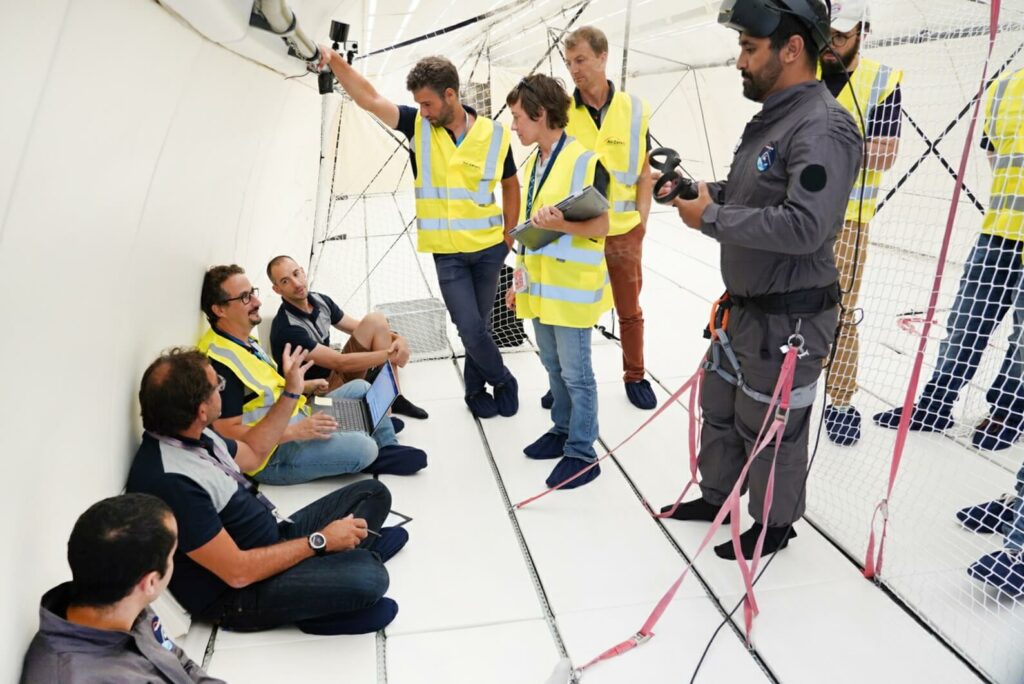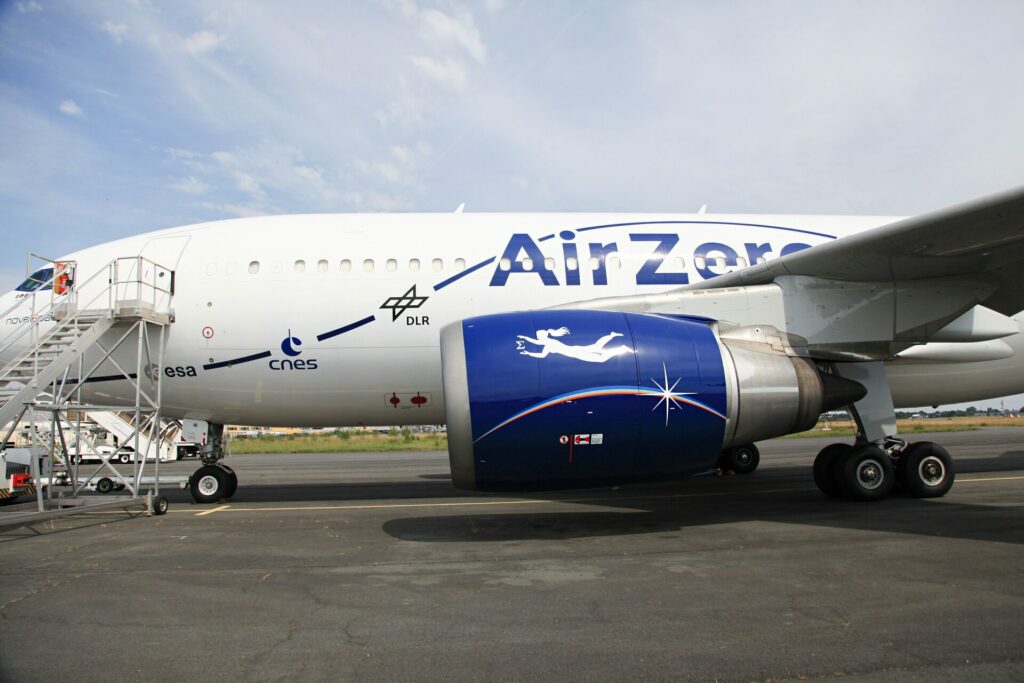Is there a life on Mars? Among the best ways to find out is to send a human mission to the so-called “Red Planet”. At present, both governmental agencies and private companies actively discuss the first manned flight to Mars. TESLASUIT has also made its contribution to the future of “Red Planet” exploration. Recently the company has taken part in the ambitious E.VA Project dedicated to supporting astronauts during the space missions.
Future astronauts will face unprecedented risks on their way to the “Red Planet”, including severe depressions and muscle atrophy. E.VA is designed as a complex virtual world to immerse space travelers into their Earth’s daily activities, such as walking in a park or meeting friends. The main idea behind the E.VA Project is to reduce the stress of long space travels through entertainment and exercising in virtual reality.
So far, TESLASUIT and its Canadian partner Next Frontier have successfully brought the E.VA Project through the Zero Gravity flight experiment – an important milestone for any space-related program. The other E.VA Project’s partner is Novespace (Air Zero G), the subsidiary of the French National Centre for Space Studies.
A flight to Mars: Why still problematic to humans?
Though human mission to Mars has been actively discussed by various space agencies for decades, there still exist numerous problems related to long-term space travel. Among them – biological difficulties endured by a human body in the state of weightlessness and mental health issues related to monotony and the lack of privacy.
Indeed, future astronauts will face strong risks during the total 150-300-day journey to Mars. Not only they will be exposed to extremely high space radiation levels, but also to bones/muscles atrophy and a long-term isolation in a cramped space. Hence, a question arises: will future astronauts be able to simultaneously cope with the effects of weightlessness and confinement, named among the major five risks to a Mars mission by NASA?
As astronauts will transition from the Earth’s gravity field to that of Mars, their coordination, locomotion, and spatial orientation will be severely affected. Moreover, their bones will lose minerals much faster in the state of weightlessness (with minerals’ density dropping by about 1 % per month compared to just 0.5 – 1.5 % per year on Earth). Astronauts’ muscle strength, endurance, and vision will also suffer, and the risk of osteoporosis will significantly increase.
Maintaining stable psychological condition of the expedition crew remains a challenging task as well. According to NASA, behavioral issues are inevitable for a group of people “locked together” for at least six month or more, even between well-trained and carefully selected team members. Among such issues – sleeping disorders, depressions, declines in mood, conflicts and poor communication between crew members. The so-called “third-quarter” effect presuming that motivation declines three-quarters of the way into a mission, no matter how long is the mission itself, might also take place.

Therefore, a major pre-flight preparation, including carrying out numerous medical studies and bringing new biotechnological solutions, should take place. Furthermore, dealing with each of those risks will require permanent biometric monitoring of astronauts’ physical and mental conditions during the flight.
What is E.VA and how can it help a human body in space?
The E.VA Project addresses both the issues of a potential physical and mental deterioration in space. The main idea behind E.VA is to create a virtual world with an interactive interface so that astronauts will be able to conduct various entertaining Earth activities in high-level virtual reality. Another important aspect of the E.VA technology is that astronauts will manage to perceive physically the virtual environment with the help of the haptic sensor technology. In this way, the E.VA solution will decrease the level of psychological stress and assist muscles’ stimulation in the state of weightlessness.
From a technological point of view, E.VA is a highly intelligent and complex software solution. It combines the technologies of artificial intelligence, deep learning, high-level virtual reality (in particular, 4K resolution for each eye with a 150 ° FOV), and a haptic feedback for sensations. For example, in the E. VA’s virtual reality astronauts will be able to walk in a forest on Earth and experience a change in temperatures. By using the dashboard, they will also manage to check their emails, watch videos, play games, and share their impressions with others. Moreover, the E. VA’s interactive interface will allow space travelers to meet their family and friends from Earth.
In this way, E.VA will strongly contribute to stabilization of astronauts’ mental health by bringing their familiar Earth experiences, increasing human contact, and providing entertainment. With the help of the E.VA system, space travelers will manage to relax and stimulate their brain activity, thus avoiding the burden of confinement on a tiny spaceship. Furthermore, by staying in the E.VA virtual world, astronauts will avoid a drastic change in their daily habits.
Currently, E.VA is projected to combine the functions of an automated “virtual psychologist” and “virtual physician”, capable of providing a double feedback. An important aspect of the E.VA technology is the system’s ability to measure its users’ stress rate with the help of biometric monitoring and provide an appropriate content based on their needs. Simultaneously, E.VA will send regular status reports on astronauts’ physical and psychological condition to doctors on Earth.
The next step in E. VA’s development is coupling the system with sports facilities to allow VR exercising in space with the help of haptic sensor technology.
Making the E.VA: International cooperation at its best
The E.VA Project has developed as a result of an exciting transatlantic cooperation between TESLASUIT, the Canadian startup Next Frontier, and the Novespace, the subsidiary of the French National Centre for Space Studies (CNES).
Next Frontier is a young and ambitious Canadian startup that creates virtual and augmented reality software solutions for a range of industries, including mining, education, and healthcare. The company’s CEO is Jason Michaud, an experienced businessman and computer scientist. The company has developed the E.VA virtual reality software for the needs of aerospace industry.
TESLASUIT has provided the full-body haptic suit with the integrated complex of motion capture, temperature control, and biometrics. TESLASUIT’s haptic technology transmits touch and thus makesthe experience in virtual and augmented reality deeper and more realistic.Apart from that, TESLASUIT allows electrostimulation based on haptics, which fosters muscle memory, stimulates neural activity, and increases VR immersion.In this way, TESLASUIT serves as an additional channel of communication between astronauts and ground control.
Novespace (Air Zero G) organises scientific parabolic flights for research in microgravity on its flying laboratory – Airbus A310 Zero G. The organisation has operated numerous scientific flight campaigns for years. On 27 August 2019, Novespace organised the first Zero-Gravity (0G) flight experiment to test the E. VA’s prototype in Bordeaux, France. In fact, the E. VA’s flight campaign was more than just a “usual” flight in zero-gravity as it lasted with 43 parables in 0G instead of the usual 15 parables.
Zero Gravity flights are an important precursor to every project before its deployment in Space. The first such flight represents an important milestone for the E.VA project. The Zero-Gravity flight experiment was needed to explore the behaviour of various G-forces and test its effects on the E.VA users. During the flight Jawad El Houssine, Next Frontier’s CTO, and software engineer Rafik El Houssine have experienced forces ranging from 0G to 2G while wearing the TESLASUIT and using VR. They have completed a number of experiments by testing their dexterity as well as physiological/psychological state under various gravity conditions. The total length of the first Zero Gravity flight lasted approximately three hours.

The European Space Agency (ESA) is also interested in possible cooperation on the E.VA and similar projects. The ESA, headquartered in Paris, stands among the leading intergovernmental organisations dedicated to space exploration. At present, the ESA has already successfully tested the E. VA’s prototype in Bordeaux. The prototype has had four test exercises completed by the French astronaut Jean Francois Clervoy (STS-88 Hubble Mission). Together with the CNES, the ESA will further assist with testing the E.VA Project in the International Space Station, located in low Earth orbit.
What is next for E.VA?
The successful Zero Gravity flight experiment has opened new perspectives for TESLASUIT and New Frontier. The partners will continue their cooperation on the improvement of E. VA’s functionality and features. At present, their major goal is to bring deeper Earth-like sensations to the system’s users.
Furthermore, the partners will conduct a range of scientific experiments to study the effects of Zero Gravity on a human body during a long space trip. Among them – physiological, psychological, ergonomic and proprioception tests.
To conclude, the development of the E.VA Project should strongly contribute to resolving the problems of neural activity deprivation and muscle atrophy in space. By doing so, E.VA will bring the human mission to Mars one step closer. The Project’s unique combination of AI, Deep Learning, VR, and Teslasuit technologies might inspire other tech visionaries and entrepreneurs to bring innovative solutions for the benefit of mankind.
About Teslasuit
TESLASUIT was first officially unveiled at the Consumer Electronics Show (CES) in Las Vegas in January 2018 where TESLASUIT was highlighted as one of the most interesting innovations presented. Authoritative high-tech media outlet Tech Crunch also considered TESLASUIT the future of full-body haptic technology. This year, TESLASUIT has been named a CES 2019 Innovation Awards Honoree in Virtual and Augmented Reality and Future Unicorn Award winner.
